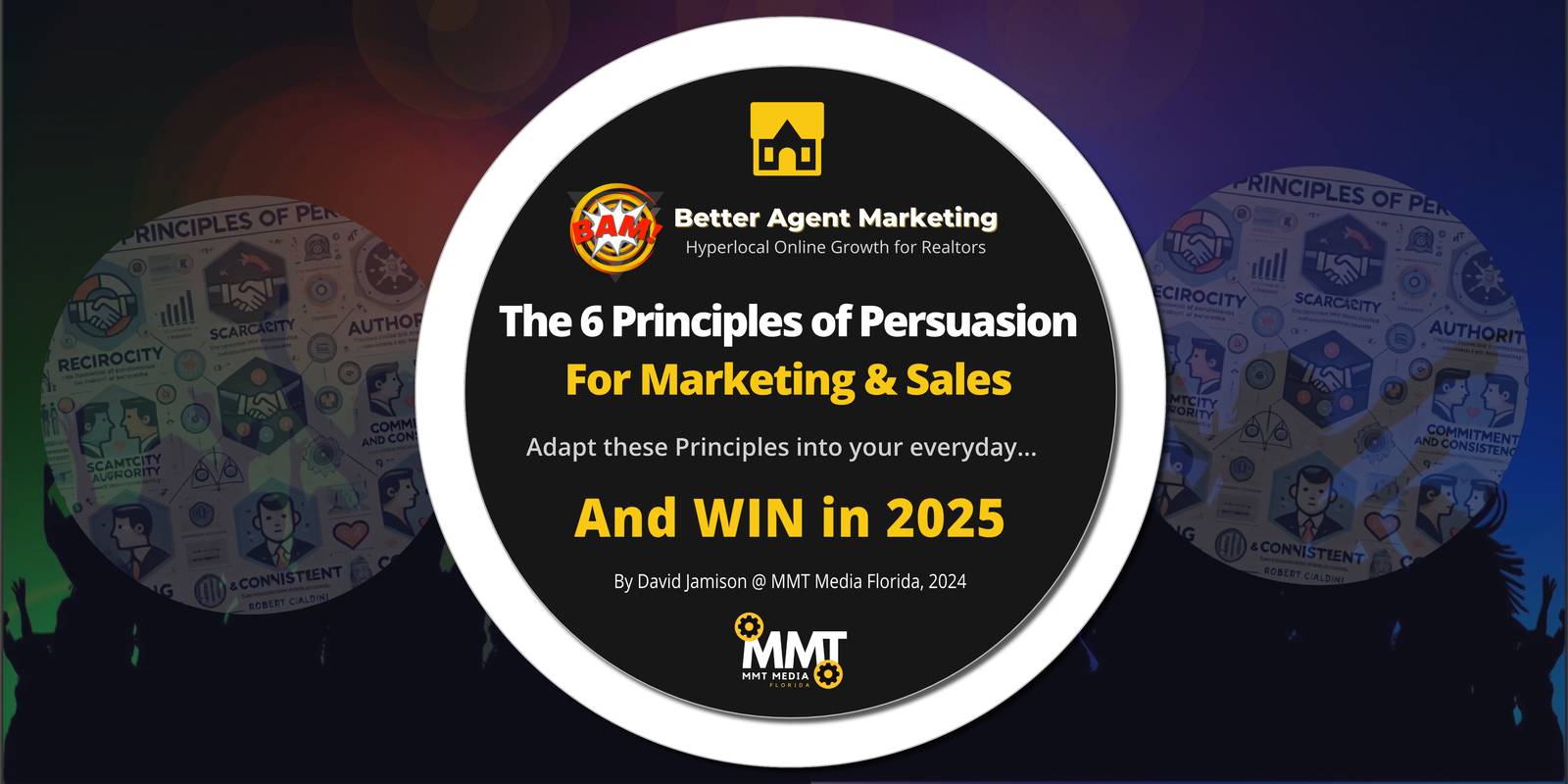# CONVERSIONS
Boost your Engagement , Conversions and Sales with these 6 Core Principles of Persuasion

The 6 Principles of Persuasion!
By Robert Cialdini
And it can be used in your Client Calls and Showings.
~ ONLINE MARKETING FOR REAL ESTATE AGENTS ~
BETTER SALES AND MARKETING IDEAS
The Problem
Creating Compelling Marketing Content is Tough. Engagement & Conversions are even Tougher. Selling Face to Face is sometimes even Harder. Why?
The Solution
Use a Proven System for Marketing Conversation as well as Sales Conversations that are known to work time and time again. Robert Cialdini Nailed it!
Better Agent Marketing's
9 Step Agent Marketing System
The 6 Principles of Persuasion
Robert Cialdini, a renowned psychologist and professor, introduced his six principles of persuasion in his book Influence: The Psychology of Persuasion. These principles are foundational in marketing, sales, and psychology, offering insights into how people are motivated to say "yes" and take action. Here’s a full rundown of each principle and how it influences behavior:
1. Reciprocity
- Definition: People feel obligated to return favors or kindnesses.
- How It Works: When someone gives us something or does something for us, we naturally feel inclined to reciprocate. This principle is grounded in the social norm that favors should be returned, which helps foster cooperation in society.
- Example in Practice: Free samples in stores are a classic example. When customers receive a free sample, they often feel a subconscious obligation to buy the product. Similarly, in digital marketing, offering a valuable free resource (like an e-book or trial) can encourage potential customers to reciprocate by considering a purchase.
- Use in Marketing: Brands use reciprocity by giving something of value first, such as free content, a discount, or a gift, to build goodwill and increase the likelihood of a favorable response.
2. Scarcity
- Definition: People want more of what they perceive to be in limited supply.
- How It Works: The scarcity principle is based on the idea that when an item is rare or there’s limited access to it, it becomes more desirable. People fear missing out (FOMO), which can drive them to take immediate action when they believe an opportunity is fleeting.
- Example in Practice: "Limited-time offer" or "Only a few left in stock" messages create a sense of urgency. This tactic is effective because it leverages people’s aversion to loss, prompting them to act quickly to secure the scarce item.
- Use in Marketing: Marketers frequently use scarcity by setting deadlines for discounts, showing limited quantities of products, or highlighting limited-time offers to push customers toward immediate action.
3. Authority
- Definition: People tend to follow the lead of credible, knowledgeable experts.
- How It Works: Humans are conditioned to respect authority figures and experts, assuming they know more about a subject and can be trusted. Authority figures can influence people’s beliefs and behaviors, especially when they display credentials, experience, or knowledge in a specific area.
- Example in Practice: Doctors or scientists endorsing a product often make it seem more credible. For instance, a toothpaste brand endorsed by dentists or a skincare product recommended by dermatologists leverages this principle.
- Use in Marketing: Brands establish authority by showcasing expert endorsements, certifications, awards, or credentials to build trust and influence consumer decisions. Personal branding through thought leadership or publishing authoritative content also strengthens this principle.
4. Commitment and Consistency
- Definition: Once people commit to something, they’re more likely to stick to it.
- How It Works: This principle is based on the desire for personal consistency. When people publicly commit to an idea or goal, they are motivated to follow through with it to maintain a consistent self-image. This is why even small initial commitments can lead to bigger commitments later.
- Example in Practice: Getting customers to sign up for a free newsletter can make them more receptive to further offers from the brand. Similarly, asking someone to take a small initial action, like clicking “I’m interested,” can lead to a stronger commitment later.
- Use in Marketing: Marketers can encourage initial, small commitments (such as signing up for a free trial or joining a mailing list) that pave the way for larger commitments. Loyalty programs, surveys, and subscription services also utilize this principle by gradually building customer loyalty and increasing brand engagement over time.
5. Liking
- Definition: People are more likely to be persuaded by people they like.
- How It Works: Cialdini’s research shows that people are more likely to say "yes" to those they find likable, attractive, or similar to themselves. This principle taps into the power of relationships and emotional connection, which influence people’s decision-making.
- Example in Practice: Salespeople and brands often build rapport by finding common ground with their audience. Influencer marketing is also a strong example—consumers are more likely to buy products promoted by influencers they like and relate to.
- Use in Marketing: Brands create likability by using relatable and friendly language, telling compelling stories, and building a brand personality that resonates with their audience. Leveraging testimonials, showing the human side of a brand, and building connections on social media are all ways to apply this principle.
6. Consensus (Social Proof)
- Definition: People look to the actions and behaviors of others to determine their own.
- How It Works: Social proof is the concept that people are influenced by what others are doing, especially when they’re uncertain. When people see others taking an action, it reinforces the belief that it’s the correct behavior, making them more likely to do the same.
- Example in Practice: Customer reviews, ratings, and testimonials are powerful forms of social proof. When people see that a product has positive reviews or that others have made a purchase, they’re more likely to feel comfortable buying it too.
- Use in Marketing: Marketers leverage social proof by displaying testimonials, user-generated content, ratings, and usage statistics. Phrases like “Join thousands of happy customers” or “Over 1 million sold” make products and services appear more credible and desirable.
Summary:
Cialdini's six principles of persuasion are effective because they tap into fundamental human psychology. Here’s a quick recap:
- Reciprocity: Give something to get something.
- Scarcity: Highlight limited availability to increase desire.
- Authority: Use experts or authoritative figures to build trust.
- Commitment and Consistency: Encourage small commitments to foster long-term engagement.
- Liking: Build connections through likability and relatability.
- Consensus (Social Proof): Show that others have chosen your product to validate its value.
By understanding and applying these principles, businesses can effectively influence consumer behavior, enhance marketing strategies, and improve customer engagement. Cialdini’s framework is powerful because it draws on universal human tendencies, making it relevant and applicable across many industries and situations.
LEARN MORE ABOUT OUR MARKETING SERVICES

How to use them in Marketing Content:
Cialdini’s six principles of persuasion can be effectively leveraged in online marketing content to influence consumer behavior, boost engagement, and drive conversions. Here’s how each principle can be applied across various types of online content:
1. Reciprocity
- Content Giveaways and Lead Magnets: Offer something valuable, like a free e-book, checklist, webinar, or trial period, to initiate a sense of obligation. For example, providing a free PDF guide in exchange for an email address not only builds your list but also encourages prospects to reciprocate by exploring more of your services.
- Discounts and Coupons: A special discount or a coupon code for first-time visitors shows goodwill, making them more likely to make a purchase and return for future transactions.
- Exclusive Content for Subscribers: Providing subscribers with access to exclusive insights or early product releases fosters loyalty and encourages further engagement.
2. Scarcity
- Limited-Time Offers and Flash Sales: Using phrases like “Only 24 hours left!” or “Ends tonight!” in social media posts, email subject lines, or banner ads creates a sense of urgency, pushing customers to act quickly before they miss out.
- Low Stock Notifications: For e-commerce websites, display messages like “Only 3 left in stock!” or “Selling fast!” next to products to drive urgency.
- Countdown Timers: Adding countdown timers on landing pages or checkout pages reinforces the idea of scarcity, especially during sales or product launches, nudging customers to complete their purchase.
3. Authority
- Expert-Authored Content: Have blog posts, guides, or whitepapers authored or co-authored by experts in the industry. This adds credibility and builds trust with your audience. For example, a fitness brand might publish articles written by certified trainers or nutritionists.
- Showcase Awards, Certifications, or Partnerships: Highlight any certifications, awards, partnerships, or recognitions that validate your expertise. For instance, displaying “Certified by X” or “Partnered with Y” logos on your website can reassure potential customers of your authority.
- Endorsements and Influencer Collaborations: Partner with respected influencers or thought leaders who can vouch for your brand, reinforcing your authority through association.
4. Commitment and Consistency
- Encourage Small Initial Actions: Use calls-to-action (CTAs) that encourage a simple step, like signing up for a newsletter, following on social media, or downloading a free guide. Once users take this initial step, they’re more likely to engage further in the future.
- Progressive Onboarding: If you offer a service that requires onboarding, break it into small steps, each reinforcing a user’s commitment to the platform or product. For example, a fitness app might start by asking users to set up a profile, then complete a short workout, and gradually introduce more features.
- Loyalty Programs and Rewards: Offer rewards for continued engagement, like discounts for repeat purchases or points for referring friends. A loyalty program reinforces consistent behavior, building a habit of returning to your brand.
5. Liking
- Build a Relatable Brand Voice: Use friendly, approachable language in your blog posts, social media, and email marketing to make your brand more relatable. Show personality, and don’t be afraid to let your team’s or founder’s personality shine through.
- Storytelling and Personalization: Share your brand’s story, values, or background to humanize your brand. Letting your audience get to know the people behind the brand can make it more likable and foster an emotional connection.
- User-Generated Content (UGC): Share customer photos, testimonials, and stories on your website and social media. When potential customers see people similar to themselves enjoying your products, they’re more likely to feel a connection with your brand.
6. Consensus (Social Proof)
- Customer Testimonials and Reviews: Display positive reviews and testimonials prominently on your website, landing pages, and product pages. People are more likely to trust real experiences from other customers.
- Showcase Social Media Engagement: Display follower counts, likes, or comments if they are substantial, as they signal popularity and credibility. You can also showcase customer engagement by highlighting comments or interactions with your brand.
- Case Studies and Success Stories: Share case studies on how customers have successfully used your product or service to solve problems. This demonstrates real-world applications and results, giving prospective customers confidence in your offerings.
- Statistics and Usage Numbers: Phrases like “Join over 10,000 happy customers” or “Trusted by 1,000 companies” provide social proof and reinforce trust in your brand.
Examples of Each Principle in Action:
Reciprocity Example: A software company might offer a “Free 14-Day Trial” on their landing page. By providing something valuable at no cost, users feel inclined to explore more of the product and may eventually sign up for a paid plan.
Scarcity Example: An e-commerce site highlights that a popular item has “Only 5 left!” This drives visitors to purchase quickly, fearing they may miss out on a desirable product.
Authority Example: A skincare brand showcases that their products are “Dermatologist-Recommended,” building credibility and assuring customers of the product’s safety and effectiveness.
Commitment and Consistency Example: A digital fitness platform offers a “7-Day Challenge” to get users to start using the app. Once users complete the challenge, they’re more likely to stay engaged and subscribe to the service.
Liking Example: A pet product brand shares relatable, funny pet videos and behind-the-scenes content of the team with their pets, creating a friendly, likable image that resonates with pet owners.
Consensus (Social Proof) Example: An online course platform displays “Over 50,000 students enrolled” for popular courses, indicating that many people trust and value the content.
Integrating All Six Principles into a Comprehensive Marketing Strategy
A successful online marketing strategy can use all six principles in combination. For example:
Landing Page: A landing page can use scarcity with a countdown timer, social proof by showing the number of people who downloaded the lead magnet, and reciprocity by offering a free resource.
Email Marketing Sequence: After the initial download, an email sequence can reinforce authority with testimonials and case studies, and commitment by encouraging small actions, like completing a survey or engaging with content.
Social Media Campaigns: Social media posts can showcase liking by humanizing the brand and social proof by highlighting user-generated content and customer stories.
Using these principles in online marketing content creates a multi-dimensional approach, tapping into psychological triggers that drive people to act. By leveraging each principle strategically, you can build trust, create urgency, establish authority, and drive consistent engagement with your brand.

How can they be used in Sales Conversations and Showings?
Leveraging Cialdini’s six principles of persuasion in sales conversations and property showings can be highly effective in building rapport, addressing buyer motivations, and ultimately guiding clients toward a decision. Here’s how each principle can be applied in phone, in-person sales, and property showing scenarios:
1. Reciprocity
- In Sales Conversations (Phone and In-Person): Start by offering helpful information or valuable insights. For instance, if you’re on a call with a prospective buyer, offer to email them a market analysis or suggest a couple of resources that could help them make an informed decision. By giving something first, you set the stage for reciprocity, where clients feel more inclined to work with you.
- In Property Showings: Offer something tangible, like a packet with property details, neighborhood information, or a list of local amenities, restaurants, and schools. At the end of the showing, this small gift fosters goodwill and increases the chance that they’ll reach out to you with follow-up questions or feel inclined to work with you.
2. Scarcity
- In Sales Conversations: Create urgency by mentioning other interested buyers or limited-time opportunities. For example, say something like, “I wanted to let you know that a few others have shown interest in this property as well.” This subtle scarcity makes the buyer feel they need to act quickly to secure the property.
- In Property Showings: Highlight unique, rare, or limited features of the property. If it’s one of the few homes in the area with a large backyard or close proximity to good schools, emphasize this. Statements like, “Homes with this layout don’t stay on the market for long,” reinforce scarcity and make the property feel more valuable.
3. Authority
- In Sales Conversations: Establish your credibility early by sharing your experience or highlighting your success in the market. You could say, “With over 10 years of experience in this area, I’ve helped many families find their ideal home.” You can also share market insights or trends, which help position you as a knowledgeable authority they can trust.
- In Property Showings: While walking through the property, share details that demonstrate your expertise. For instance, discuss the quality of the materials used, the benefits of the floor plan, or comparisons with similar properties in the area. If a potential buyer asks about renovations, providing in-depth knowledge of what adds value shows authority and reassures them about the investment.
4. Commitment and Consistency
- In Sales Conversations: Start with small commitments to build momentum. For example, ask them to confirm minor decisions or preferences like, “Do you prefer a larger backyard or a bigger kitchen?” These small “yes” answers increase their commitment. Over time, they’ll be more inclined to follow through with bigger decisions, such as setting up a showing or making an offer.
- In Property Showings: Get them to visualize themselves in the home by asking questions like, “Can you see yourself hosting family dinners here?” or “How would you decorate this room?” These prompts encourage clients to mentally commit to the property, increasing the likelihood of a final decision. After the showing, ask for a small next step, such as a follow-up call or discussing financing options.
5. Liking
- In Sales Conversations: Build rapport by finding common ground. If they mention their family, share a little about your own to create a connection. People are more likely to work with someone they like, so display genuine interest, be personable, and use humor if appropriate.
- In Property Showings: Compliment their good taste or preferences as you go through the property. For example, if they’re excited about a certain room, validate their choice by saying something like, “Yes, I can see why you love this kitchen; it’s such a great space.” Showing you understand and support their tastes makes you more likable and relatable.
6. Consensus (Social Proof)
- In Sales Conversations: Mention other clients with similar preferences or situations who found satisfaction through working with you. For instance, say, “I recently helped a family just like yours find a home in this area, and they’ve been thrilled with the neighborhood and schools.”
- In Property Showings: Highlight positive feedback from others or how previous residents enjoyed the home. For example, “The current owners loved hosting family events in this backyard,” or “A lot of families in this neighborhood love how close they are to local parks and schools.” This social proof reassures buyers that they’re making a good choice.
Applying All Six Principles Together in Property Showings:
Imagine walking a potential buyer through a home. Here’s how a conversation might go, incorporating all six principles subtly:
Reciprocity: You greet them warmly and hand them a packet with neighborhood highlights, property details, and local amenities. “I put together this information for you so you can get a feel for the area.”
Scarcity: As they show interest in the living room, you mention, “Homes in this style, especially with such a spacious backyard, tend to move quickly around here. There’s been a lot of interest in similar properties recently.”
Authority: As you tour the kitchen, you note, “The builder used high-quality materials in this space, and it’s rare to find this level of finish in this price range. In my experience, kitchens like this add a lot of value over time.”
Commitment and Consistency: You ask, “Could you see yourselves having family gatherings here?” As they start picturing themselves in the space, you reinforce their attachment with positive affirmations.
Liking: When they comment on a room they particularly like, you connect by saying, “You have great taste! I love that space too—it’s perfect for relaxing.” By relating to their preferences, you make yourself more likable.
Consensus (Social Proof): As they move through the home, you mention, “The neighbors here really love the community feel and often have get-togethers. Everyone I’ve spoken to says it’s a wonderful place to raise a family.”
By combining these principles, you create a persuasive experience that builds rapport, addresses motivations, and guides clients naturally toward a decision. With practice, these principles become second nature, enhancing your effectiveness in sales conversations and property showings. Let me know if you’d like specific scripts or more tailored strategies for a particular principle!
ONLINE MARKETING FOR REALTORS
MARKETING SERVICES
Get your Online Presence launched and producing Leads for you 24/7/365
Agent LeadFlow System
Your Complete Agent D.I.Y. Content System
Click the Image Above to Learn More






